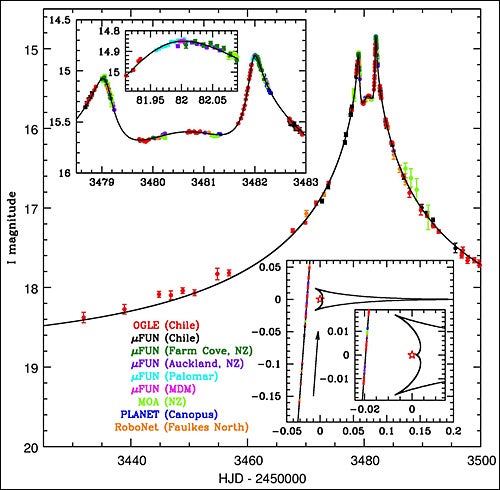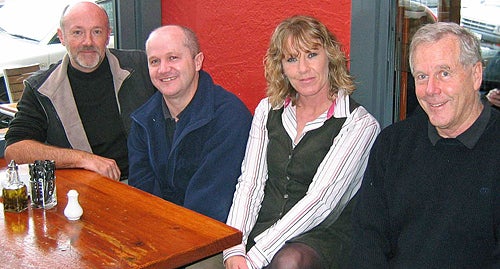A worldwide collaboration of amateur and professional astronomers today announced the discovery of yet another Jupiter-like planet circling a distant star. Perhaps the most significant aspect of the find, dubbed OGLE-2005-BLG-071, is what the discovery portends for future planet searches — and for the narrowing gulf between professionals and amateurs.
Princeton astronomer Bohdan Paczynski and then-student Shude Mao first proposed gravitational microlensing as a means to search for extrasolar planets in 1991. With stellar microlensing events, distant starlight becomes temporarily magnified when a background star aligns with a foreground object along the line of sight to Earth. If the foreground star possesses a planet, as in the case of OGLE-2005-BLG-071, changes in the magnified light can reveal it.
Based on tightly constrained models of the lensing event, Gould and his colleagues calculate the new planet possesses 1 percent of the mass of its parent star, placing it well into the range of Jupiter-mass exoplanets. Models also indicate OGLE-2005-BLG-071 orbits its host star at a distance comparable to the Earth-Sun separation. The system lies between 15,000 and 20,000 light-years away from Earth, toward the Milky Way’s center. Astronomers are planning follow-up observations with the Hubble Space Telescope later this month and again next February to pinpoint the planet’s mass and distance from Earth.
On the morning of April 18, as twilight crept into the sky above the 51-inch Warsaw Telescope at Las Campanas Observatory, Chile, astronomers with the Optical Gravitational Lens Experiment (OGLE) and the Microlensing Follow-Up Network (MicroFUN) issued a worldwide alert about the OGLE-2005-BLG-071 lensing event. For the next 3 days, astronomers in North America, South America, and New Zealand raced to gather data as the event unfolded.
Two Auckland, New Zealand, amateurs played a critical role in the planet’s discovery. Grant Christie and Jennie McCormick heard about the alert and decided to join the search. Christie observed using the Auckland Observatory’s 14-inch telescope. McCormick used her 10-inch Meade LX200 at her Farm Cove Observatory. With perfect skies over Auckland, Christie and McCormick were able to capture 12 hours of critical data near the peak of the planet-lensing event.
“At home at Farm Cove, I know I can get on to whatever target I want, when I want, and go all night if I want. That’s something you just can’t do with a professional observatory,” says McCormick. “It’s really fun knowing that one day you might hit the big one, as we seem to have with BLG-071. It just shows that you can be a mother, you can work full-time, and you can still go out there and find planets,” she says.
McCormick has logged many hours observing cataclysmic variable stars with her f/10 scope and SBIG ST-7E CCD camera, contributing her observations to the Center for Backyard Astrophysics — a worldwide collaboration of 50 independent stations managed by Columbia University’s Joseph Patterson. But she never expected to be involved with such an important discovery. As it turns out, neither did her professional counterparts.
“I’m just ecstatic about the quality of the data and the great enthusiasm that [Christie and McCormick] have shown for the project,” Gould tells Astronomy. “We would love to get more amateurs involved.”
The discovery is only the second such planet detected through microlensing, but it validates the technique, which can be used to search for low-mass Earth-like planets many suspect are out there. “If an Earth-mass planet was in the same position, we would have been able to detect it,” notes Gould.
“The one thing you’d really like to know before you fly a multi-million-dollar mission like [NASA’s] Terrestrial Planet Finder is the probability for finding Earth-mass planets,” notes Paczynski. “In principle, there’s nothing preventing us from providing that answer. It’s just a matter of a little more time and data.”
Other teams contributing observations include Microlensing Observations in Astrophysics (MOA), and Probing Lensing Anomalies NETwork (PLANET). A full account of OGLE-2005-BLG-071’s discovery will be published in an upcoming issue of The Astrophysical Journal Letters.











